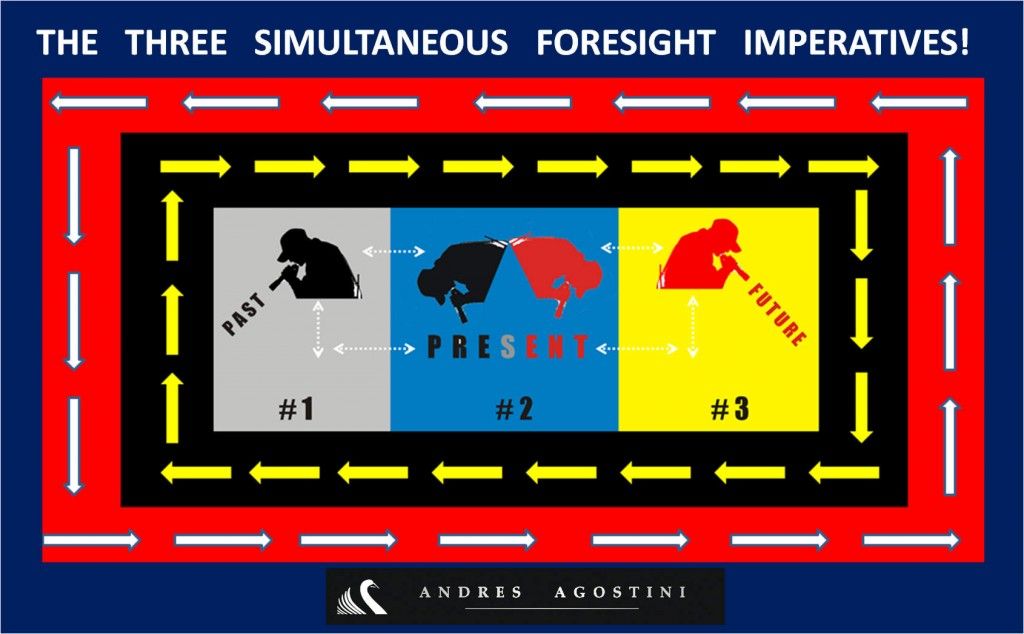FUTURISM UPDATE (November 19, 2014) — Mr. Andres Agostini, Amazon
FINANCIAL TIMES: Object 2014-28E – Space junk or Russian satellite killer? It is a tale that could have come from the cold war. A mysterious object launched by the Russian military is being tracked by western space agencies, stoking fears over the revival of a defunct Kremlin project to destroy .… http://lnkd.in/d-YWkfx
ZDNET: Data science: ‘Machines do analytics. Humans do analysis’ http://lnkd.in/dzfvjdp
TIME: New York Is Transforming Its Old Payphones into Wi-Fi Hotspots http://lnkd.in/dqHpQUW
Forbes: Databox Launches Enterprise Mobile Insight Solution. But Is It Analytics? http://lnkd.in/dbVMBUM
Hospitality Net: Big data and big analytics are a big opportunity for hotels — Part 2 http://lnkd.in/d4SNrPi
Financial Times: The nuclear gun is back on the table. Both in private and in public, Russia is making explicit references to its nuclear arsenal http://lnkd.in/d3ycdFG
Financial Times: Bonds: Anatomy of a market meltdown. Fall in Treasury bond yields left investors asking if world’s safe haven needs shoring up http://lnkd.in/dqCR5pQ
Financial Times: Nokia partners with Foxconn to take on Apple with tablet device http://lnkd.in/dT8dTae
The Financial Times observes that President Putin and President Obama are threatening each other with their respective nuclear arsenal. We are getting closer to M.A.D. WWIII.
Financial Post: Who will blink first as global oil prices collapse? http://lnkd.in/dP7EcuU
Christian Science Monitor: Halliburton, Baker Hughes merge as oil prices plummet http://lnkd.in/dcrZGF4
COMPUTER WORLD: Yahoo’s Genome highlights hosted big data analytics trend. Several companies have begun offering big data analytics as a service http://lnkd.in/dFbMtr2
BLOOMBERG: Nigeria Budget-Cut Pledge Falls Short as Oil Prices Drop http://lnkd.in/dnRiJXH
Bloomberg: Oil Slide Prompts Iran’s Oil Minister to Visit U.A.E. http://lnkd.in/dAujidM
WIRED: Leading the Way for Big Data Startups, Yahoo Spin-Off Files for IPO http://lnkd.in/dvXidUy
MIT Technology Review: Driving Marketing Results with Big Data http://lnkd.in/dWhvszA
MIT Technology Review: Machine-Learning Algorithm Ranks the World’s Most Notable Authors. Deciding which books to digitise when they enter the public domain is tricky; unless you have an independent ranking of the most notable authors. http://lnkd.in/dCwMJwW
MIT Technology Review: Nanoparticle Detects the Deadliest Cancer Cells in Blood. A novel kind of nanoparticle could lead to more effective cancer treatments. http://lnkd.in/dbRzqQH
MIT Technology Review: When AI Experts Have “It’s Alive!” Moments. Occasionally virtual assistants like Siri show flashes of humanity that suggest they could one day act like more than just software. http://lnkd.in/dKXXEhF
Moneycontrol.com: Expect Gold, Silver prices to trade on lower note: Angel http://lnkd.in/dYq_KNt
The Market Oracle: Gold, Silver, Crude and S&P Ending Wedge Patterns http://lnkd.in/d-D3WSW
Center for Research on Globalization: Gold and Silver Price Manipulation: The “Golden” Cat is Out of The Bag! http://lnkd.in/dWpyJja
Telegraph.co.uk: Vladimir Putin vows that United States ‘will never subjugate Russia’ Russian president echoes Al Capone as he says ‘weapons and politeness’ are better than ‘politeness alone’ http://lnkd.in/dxJhDR4
New York Times: Who Won in Putin’s Feud With West? Organic Farms http://lnkd.in/dmfpf-e
Reuters: Isolated at G20, Putin shows he will do it his way in Ukraine http://lnkd.in/dkiZPa2
The Guardian: Finland back on red alert over expansionist Russia. Almost a century after breaking free from its giant neighbour Helsinki still follows Moscow’s every move http://lnkd.in/dHUpfJA
BBC News: Russia tests ‘satellite catcher’. Russia may be testing a satellite capable of chasing down other orbiting spacecraft, observers say. Such technology could be used for a wide variety of uses, including to repair malfunctioning spacecraft, but also to destroy or disable them. http://lnkd.in/duYz6MH
Washington Post: A mysterious Russian space object could be the return of the ‘satellite killer’ http://lnkd.in/dexVMeV
New York Times: Merkel Issues Rebuke to Russia, Setting Caution Aside http://lnkd.in/dhWejmi
Bloomberg: Russia Sees Recession Next Year If Oil Price Falls to $60 http://lnkd.in/dYDyW3C
National Post: Vladimir Putin’s plan: He took Crimea. He’s taunting NATO. What will Russia’s president do next? http://lnkd.in/d-fypU5
MOSCOW TIMES: Russia’s Isn’t the Only ‘Satellite Killer’ in Space. A previously unknown Russian spacecraft conducting maneuvers characteristic of a satellite killer has sparked concerns that Russia’s military provocations may soon extend to space, but experts say Russia is not the only major space power developing agile — and potentially deadly — capabilities in Earth’s orbit. Western space agencies, militaries and amateur observers are tracking a mysterious Russian satellite that could be a satellite hunter — a spacecraft that trails enemy satellites and then destroys or disables them, The Financial Times reported on Monday. Amid Russia’s showdown with the West over Ukraine the discovery looks ominous, but all the big space-faring nations — Russia, China and the U.S. — are developing similar capabilities, Robert Christy, a veteran amateur satellite tracker, told The Moscow Times by phone. http://www.themoscowtimes.com/business/article/russia-s-isn-…11403.html
MOSCOW TIMES: Russia Readies for Showdown Over Taxing Offshore Companies http://lnkd.in/dqdi6CJ
Deutsche Welle: Sticking points remain in Iran nuclear dispute http://lnkd.in/dn-xMuG
Deutsche Welle: ‘No reason for optimism’ over Ukraine. With tensions high between Russia and the West over Ukraine, German Foreign Minister Frank-Walter Steinmeier is in Moscow for high-level talks. He is the first senior European minister to visit the Kremlin since July. http://lnkd.in/df2YdA3
CIO: How to Be the CIO of Tomorrow http://lnkd.in/dmsvcGT
Wall Street Journal: Japan to Name Hiromichi Mizuno CIO of Public Pension Fund. Mizuno Currently a Partner at Private-Equity Firm Coller Capital http://lnkd.in/db7-W8M
Computerworld: 10 hottest IT skills for 2015 http://lnkd.in/dt3BiQh
PCWorld: Google program mimics human brains and vision to automatically caption photos http://lnkd.in/dCByHMh
PCWorld: Intel turns to light beams to speed up supercomputers http://lnkd.in/dZnAeJt
PCWorld: China disrupts some websites linked to US content delivery network http://lnkd.in/d-Ae9dc
SWISS INFO: Jail time demanded for bad bankers http://lnkd.in/dUQghHh
New York Times: What Does the Proposed Keystone XL Pipeline Entail? The Keystone oil pipeline system is designed to carry up to 830,000 barrels of petroleum per day from the oil sands of boreal forests in Alberta, Canada to oil refineries and ports on the Gulf Coast. http://lnkd.in/dkex5dq
FOREIGN AFFAIRS: Dragon Net. China’s Next Economic Miracle. With 632 million Internet users, China has already become the world’s largest e-tailing market, with almost $300 billion in sales posted in 2013. http://lnkd.in/dQCmQeD
REUTERS: Lufthansa signs $1.25 billion outsourcing deal with IBM http://lnkd.in/d_uKHpB
Broadway World: Capgemini Announces Cloud-Based SAP Software Implementation Project with Excelerate Energy http://lnkd.in/dpqm4Pi
ZME Science: Robot Underwater Gliders show How Antarctic Ice is Melting http://lnkd.in/dS6Pfeu
ABC News: A physics professor at the California Institute of Technology sued the school Thursday, claiming she faced a “merciless campaign” of retaliation for telling the FBI that she suspected illegal activities at the university-managed NASA Jet Propulsion Laboratory. http://lnkd.in/dTyJCdu
Salt Lake Tribune: Google buys Dutch wind energy for data center http://lnkd.in/dczc85c
New Zealand Herald: Why Google, Microsoft, and Yahoo are buying up wind energy http://lnkd.in/d7KDxbu
New Scientist: Is mystery Russian spacecraft a satellite-killer? Is it watching the watchers? Russia has launched a spacecraft that is whizzing around low Earth orbit visiting satellites, it emerged this week. The mystery craft has renewed fears that Russia has revived its interest in developing anti-satellite weapons, a programme thought to have been abandoned in the 1980s. http://www.newscientist.com/article/dn26586-is-mystery-russi…GvuB8n5N30
SLATE: Why Putin may be more dangerous than ever: http://slate.me/1vnaegf
FORBES: Lighter Than Air? Toyota’s Quixotic Plan To Sell Hydrogen Cars Feels Almost Real http://lnkd.in/dnDSrmz
BLOOMBERG: Catalonia’s Independence Push Puts Real Estate Revival at Risk http://lnkd.in/dCea8ct
IrishCentral: If Spain breaks up, what are the implications for Northern Ireland? http://www.irishcentral.com/opinion/others/If-Spain-breaks-u…eland.html
BUSINESSWEEK: Quebec and Scotland Said No to Secession, but Catalonia Is Still Going to Try http://www.businessweek.com/articles/2014-11-13/cata…dence-vote
BBC News: Ukraine crisis: Russia demands guarantees from Nato http://lnkd.in/dx9fHMn
Recruiter: One third of jobs in the UK are at risk from automation within 20 years, according to a joint report from Deloitte and Oxford University. http://lnkd.in/dB9B47u
Smithsonian: Look How 30 Years of Automation Changed How Crayons Are Made http://lnkd.in/daXaT3N
Daily Mail: Will YOUR job still exist in 2025? New report warns 50 per cent of occupations will be redundant in 11 years time http://lnkd.in/dWYbqcy
Wall Street Journal: The Problem With Blind Faith in Technology and Job Creation http://lnkd.in/dExayQE
WealthManagement.com: The Headwinds That Could Lead to a Global Depression http://lnkd.in/dgP38UB
BY MR. ANDRES AGOSTINI
White Swan Book Author (Source of this Article)
http://www.LINKEDIN.com/in/andresagostini
http://www.AMAZON.com/author/agostini
http://www.appearoo.com/aagostini
http://connect.FORWARDMETRICS.com/profile/1649/Andres-Agostini.html
@AndresAgostini
@ThisSuccess


